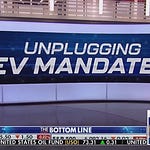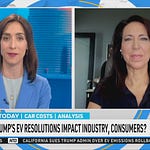ITS OVER! Trump's 'Big Beautiful Bill,' Ends EV Tax Credit September 30
By Lauren Fix, The Car Coach
Congress just sent a jolt through America’s automotive industry - and this time, it’s not about subsidies or mandates. It’s about getting Washington out of the driver’s seat.
On July 4, 2025, Congress passed, and President Trump signed, what’s being called the “One Big Beautiful Bill Act.” Catchy name aside, this legislation is packed with major changes that will affect your next car, your fuel bill, and maybe even your job. Whether you’re a mechanic, a car dealer, or someone simply trying to afford a reliable ride, this bill deserves your full attention. It dismantles a decade of EV favoritism, slashes penalties for automakers, and repositions gas-powered vehicles squarely back in the spotlight.
Let’s break it down - without the fluff - and explain exactly why this matters to you.
EVs at the Curb: USPS Forced to Sell Off Thousands of Electric Trucks
This legislation starts by hitting reverse on the U.S. Postal Service’s electric vehicle program. That’s right - about 7,200 electric mail trucks, part of a multi-billion-dollar green fleet initiative were on the chopping block. The program is being scaled back and no longer funded. But in the meantime, the administration will refocus the Postal Service on delivering mail - not testing environmental policy.
This move reverses a $9.6 billion investment in further funding for electric vehicles. Ford’s custom-built E-Transit vans, developed specifically for the USPS, were at risk of being sold off, but the parliamentarian ruled that a 60% majority was required in order for this to happen. Finding buyers for a purpose-built fleet isn’t as easy as flipping used pickups. If no one wants them, the American taxpayer could be left footing the bill. This could become a future vote or be defunded later.
A Hard Reset on EPA Overreach and Fuel Standards
Next up: the Environmental Protection Agency.
This bill takes direct aim at overreaching emissions mandates by eliminating California’s ability to set its own tougher vehicle emissions standards. California’s EPA waiver had long allowed the state to push automakers into building more EVs and hybrids - regardless of what the rest of the country wanted. That’s over. And with it, the ripple effect on nationwide vehicle standards could collapse.
More importantly, the bill removes the penalties automakers faced for missing fuel economy targets. Companies like Stellantis paid nearly $191 million in fines during just one two-year window (2019–2020) under CAFE standards. Now, those penalties are set to zero.
This gives automakers breathing room - and the ability to focus on building vehicles Americans actually want to buy: SUVs, trucks, and gas-powered cars with real utility or hybrid vehicles. Not battery-powered compliance boxes.
EV Tax Credits: Ending Sooner Than You Think
Here’s the part that really flips the EV market upside down: the tax credits are going away - and sooner than expected.
The $7,500 tax credit for new EVs and the $4,000 credit for used EVs will vanish after September 30, 2025 - a full three months earlier than the House originally planned. And it gets more aggressive: leased EVs from non-U.S. automakers lose their credits immediately. The EV charger tax credit also ends in June 2026.
What remains? A manufacturing tax credit for U.S.-built EV batteries, but even that excludes any company with links to China.
This is a major economic pivot. With EVs costing an average of $9,000 more than gas-powered vehicles, losing these incentives could price many buyers out of the market. Analysts are forecasting a 72% drop in projected EV sales over the next decade, along with a possible loss of 80,000 U.S. jobs and $100 billion in expected investment.
Tesla may survive the fallout. But other automakers — like Ford and Hyundai — will likely delay or scale back future EV development. Expect fewer EV ads, slower rollouts, and more conventional models hitting showrooms.
The Road Ahead: More Gas Cars, More Choice, More Questions
So what does all this mean for you, the driver?
Gas-powered vehicles are poised for a strong comeback. With emissions penalties gone and EV credits phasing out, automakers are incentivized to lean back into what already works. Expect more variety, lower prices, and vehicles designed for the actual demands of American families and businesses.
Fuel demand is expected to stay high - and that’s good news for domestic energy production. Oil and gas industries have long warned that EV policy was artificially distorting the market. Now, that distortion is being corrected.
Still, the bill isn’t one-sided. There’s a proposed tax deduction for buyers saddled with auto loan interest - a nod to the growing number of Americans financing vehicles in a high-rate environment. It’s a way to offer relief without distorting the product landscape.
And while an annual $250 EV road-use fee didn’t make it into the final bill, don’t be surprised if that resurfaces in the next round of negotiations. Right now, gas drivers pay federal fuel taxes that help fund roads and infrastructure. EVs pay nothing. That imbalance may not last. This fight could be taken up by the EPA or the Department of Transportation.
Winners and Losers: Who’s Benefiting and Who’s Scrambling
This legislation favors automakers willing to build vehicles Americans want - not those chasing regulatory credits. It’s a win for traditional manufacturers, oil and gas workers, and dealers in heartland states where EV demand has always been low.
It’s a loss for global automakers betting big on electric growth in the U.S. market - especially those with heavy investment in Chinese battery supply chains. And it’s a headache for urban planners, utilities, and environmental groups counting on mass EV adoption to hit clean energy targets.
The National Automobile Dealers Association (NADA), CarMax, and others were were pushing for a longer transition period. They feared a sudden market disruption. Meanwhile, critics of the bill claimed it jeopardizes climate goals, raises future utility bills, and hands the EV lead to countries like China.
Why You Should Care
This isn’t just a debate about cars or clean air - it’s a fight over how much control government should have over your choices, your money, and your mobility.
Do you want a vehicle that fits your life, your budget, and your needs? Or do you want a central planner in Washington - or Sacramento - dictating your options? That’s the question this bill forces us to ask.
By pulling back mandates, cutting artificial market manipulation, and letting consumers - not bureaucrats - drive the demand, this bill aims to restore sanity to an industry that’s been distorted by politics and ideology for too long.
It’s not perfect, but it’s a start.
So think carefully about what this means, not just for the next car you buy - but for the future of freedom on America’s roads.
You can support me by buying me a cup of coffee. Thanks for subscribing and your support! https://www.buymeacoffee.com/laurenfix
Looking for more automotive news?
https://www.CarCoachReports.com
Total Car Score Podcast ► https://www.revolverpodcasts.com/shows/total-car-score/
Lauren Fix is an automotive expert and journalist covering industry trends, policy changes, and their impact on drivers nationwide. Follow her on X
@LaurenFix for the latest car news and insights.















Share this post